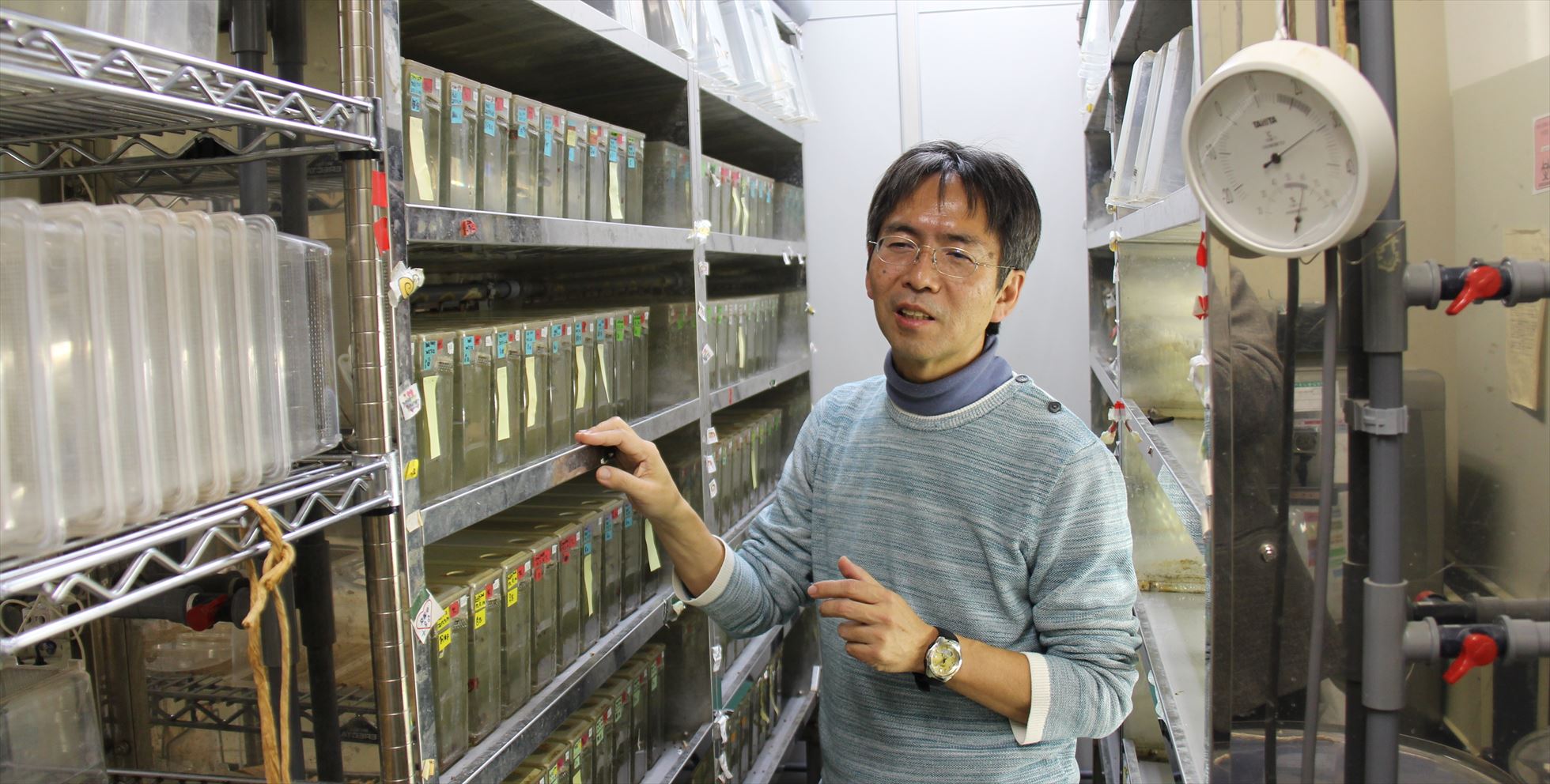TSUKUBA FUTURE
#084 Why I'm fascinated by zebrafish
Assistant Professor KOBAYASHI Makoto, Faculty of Medicine

People age, and there is nothing we can do about it. But all people want to be as healthy as possible. Prof. Kobayashi uses zebrafish to investigate how antioxidant foods help prevent oxidant stress, which accelerates aging. This has become linked to research into the mechanism which generates hematopoietic stem cells, which are the source of blood cells. Prof. Kobayashi also uses zebrafish to probe the mechanism which generates hematopoietic stem cells, which is currently not understood.
Zebrafish, native to India and approximately 3-4cm in length, were given their name due to the horizontal stripes along the adult's body. Not only are they sold in specialist tropical fish pet shops, they are also bred in bio-medical laboratories. The zebrafish are highly effective for use in experiments as they can be bred easily, egg harvesting is simple, genetic manipulations are well established, and the eggs and juvenile fish are transparent. What is more, zebrafish share approximately 13,000 of the more than 20,000 human genes. There are even genes shared by humans and zebrafish which cannot be found in mice, the standard model animal. Prof. Kobayashi has specifically selected zebrafish to be the core of his research due to the fact that, not only do they help us understand a great deal, but there are things which cannot be understood without them. The most beneficial points are the ability to use fluorescent light imaging to illuminate only the "switched on" parts of specific genes, and the ability to use the fish as chemical-biological material for explaining life phenomena using molecular biology and chemical methodologies.

Zebrafish breeding laboratory. The small transparent containers on the shelves are water tanks. Males and females are bred in separate tanks, and only meet during egg harvesting.
To research oxidative stress, said to be the cause of both cancer and aging, the effectiveness of substances with antioxidant properties can be validated simply by drizzling them on zebrafish eggs under oxidative stress. The transcription factor Nrf2 plays an important role in the defence against oxidative stress. Large quantities of anti-oxidative stress proteins are generated when this Nfr2 protein is activated. Activating agents are electrophilic substances found in functional foods such as broccoli sprouts, turmeric, and so forth. There are many substances which can activate Nrf2 and many ways in which they can be activated. Prof. Kobayashi has generated mutant zebrafish lines unable to respond to electrophilic substances to help him investigate this wide range of activation mechanisms, and has also produced Nrf2 mutant lines, the use of which enables Prof. Kobayashi to investigate antioxidant effects in which Nrf2 is not involved. However, Nrf2, which plays an important role in antioxidant action, can also play the villain. Activation of Nrf2 energizes cancer cells and promotes the proliferation of cancer. On the other hand, the activity of Nrf2 is closely related to longevity and/or aging. For example, the basal level of Nrf2 activity is quite high in naked mole rats, a rare breed of social rodents who has a very longer lifespan of up to thirty years than other rodents. Should Nrf2 be activated? Or perhaps not? This is not a simple question, the answer to which lies in where, when and how it functions. Prof. Kobayashi is very enthusiastic about his pursuit of uses for Nrf2 in the promotion of good health including the prevention of cancer.


An adult male zebrafish (top) and an embryo (blood vessels illuminated using green fluorescence protein).
It is said that the human body contains 26 trillion red blood cells. Around 200 billion are renewed every day, a complete renewal cycle taking four months. These, and all the other types of blood cells, including white blood cells, platelets, and immune cells, are produced in bone marrow by hematopoietic stem cells. In humans, these stem cells are produced from blood vessels in the fetal period, and in zebrafish the same thing happens in the embryonic stage. This was verified independently, and simultaneously in 2010, by research groups in the United States, France and the Netherlands. Images of zebrafish blood vessel epithelial cells rotating and suddenly jumping out have been published. Approximately twenty hematopoietic stem cells are produced in this way. This is the only time in the lifespan of an individual that hematopoietic stem cells are produced. Prof. Kobayashi isolated a mutant line in which the number of hematopoietic blood cells decreases, probably because newly generated hematopoietic stem cells cannot jump out from the blood vessels. The responsible gene of this mutant encodes LSD1, which is known to promote cancer metastasis. The fact is that in cancer metastasis, a rounded cancer cell in the cancerous tissue rotates and jumps out into the blood stream. It is possible that research into this mechanism which prevents zebrafish from producing hematopoietic stem cells, may enable us to prevent cancer metastasis. Prof. Kobayashi is drawing in on this mechanism.

Science illustration lessons are offered in collaboration with Professor Sayoko Tanaka from the School of Art and Design. This piece explains the importance of zebrafish as a model animal. By 4th-year art student Mayu Soda (2012)
Article by Science Communicator at the Office of Public Relations



